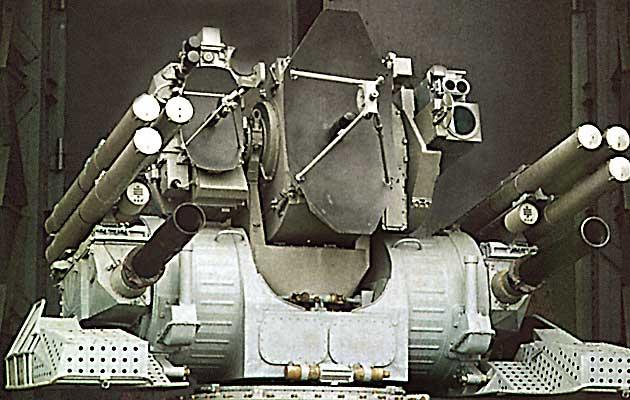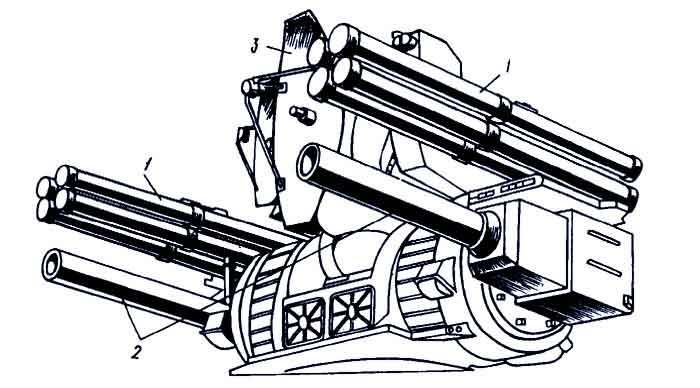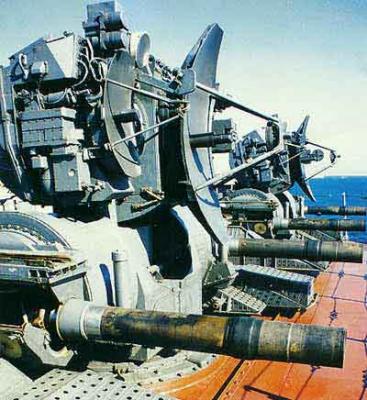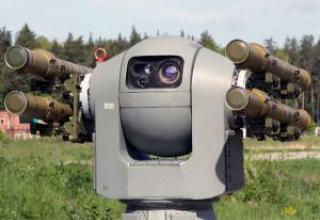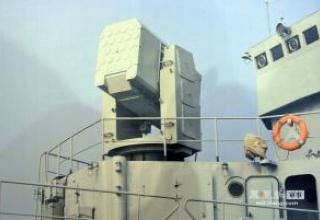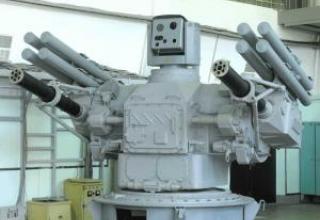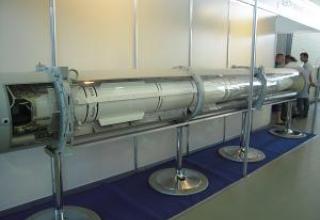Anti-aircraft missile and artillery system ZM87 "Kortik" - a system of self-defense of surface ships, designed to hit targets with missiles at the range from 8000 to 1500 m, and then completed the surviving targets 30 mm assault rifles AO-18 at a distance from 1500 to 500 m.
It was established in the late 1970s in the Instrument Design Bureau (KBP) (Tula) under the leadership of General Designer A.G. Shipunov. Later it received the "pseudonym" of "Chestnut", under which it was offered for export. Manufacturer - Tula Engineering Plant
In 1983, a prototype of ZM87 (one module) was installed on a rocket boat at Ave. 1241.7 "Lightning" Ave. (Flight No. 952). Ship-based tests of the complex took place at the Black Sea. The ZM87 complex was put into service in 1989.
Eight ZM87 modules were installed on the aircraft carrier at 1241.7 "Lightning" prospectus. 1143.5 "Admiral Kuznetsov", six modules - on the atomic cruiser of Ave. 1144 "Admiral Nakhimov", two modules each - on two SCR pr. 1154 "Undaunted" type.
In the west, the complex was designated SA-N-11 "Grison" .
Composition:
The Kortik complex includes one command module and from one to six combat modules.
The command module includes a target detection radar and an information processing, target distribution and designation system.
The combat module consists of an artillery missile launcher and a control system consisting of a radar and television optical channel.
On the rotary part of the complex are mounted two blocks of 4 or 3 missiles, placed in cylindrical transport and launch containers weighing 60 kg. Two-stage solid fuel missile 9M311K (later the letter "K" was removed from the index) is unified with a missile of the military air defense complex 2K22 "Tunguska". The missile control system is semi-automatic with a radio command line. The fuse is non-contact with a radius of 5 meters. Rocket 9M311 - the only domestic ship-based SAM system with a shrapnel-core combat unit. The length of the rods is about 600 mm, diameter 4-9 mm. The top of the rods is a "shirt" containing ready-made fragments - cubes weighing 2-3 grams. At breakage of a warhead the rods form something like a ring in radius of 5 meters in a plane perpendicular to a rocket axis. At a distance of more than 5 meters, the action of rods and fragments is ineffective.
The artillery unit consists of two 30-mm six-barreled units with ballistics and AK-630 ammunition. The total firing rate is about 10,000 lb/min. In contrast to the AK-630, the barrel units are equipped with inflators to protect the unit and containers with missiles from gunpowder gases. The ZM87 is located not in a turret, but in two drums of 500 rounds each, located near the barrel blocks. The rifles are powered not by ribbons, but by augers (suspended).
The Kortik complex allows firing at up to 6 targets per minute. Rockets 9M311 hit targets in a corridor 350m wide right and left of the installation, at a distance of 8km for aircraft and 5km for PCR. Modular design and small mass characteristics allow to place the complex on ships from missile boats to aircraft carriers, as well as on ground objects.
By the end of 1994 production of "Kortika" was stopped. Though initially it was supposed to replace by "Kortik" at least the most part of art installations of AK-630, both on ships under construction and on ships in service, for what the ball epaulet and other installation parts of AK-630 and ZM87 have been unified. However, on ships of a number of projects "Kortik" does not pass the height from the deck (2250 mm compared to 1070 mm at the AK-630).
Characteristics:
| Range, km | up to 8 |
| Number of simultaneously fired targets | up to 6 |
| Weight of the ZUR, kg | 43.6 |
| Weight BC, kg | 15 |
| Average flight speed of ZUR, m/s | 600 |
| Maximum flight speed of the targets to be hit, m/s | 500 |
| Maximum overload for maneuvering the affected targets,g | 7 |
| The mass of the complex, t | 13.5 |
Testing:
One of the first carriers of the complex is a multipurpose nuclear submarine of the project 885 "Ash", which belongs to the fourth generation of submarines. The keelmark in the series, called "Severodvinsk", took place on December 21, 1993. The boat carries 24 missiles in inclined launch shafts. The natural model of the new anti-ship missile in an export version (a variant for underwater, surface and shore-based), was first publicly demonstrated at the exhibition MAKS-97. It was also exhibited at MAKS-99.
The advertising passport for the small rocket ship of project 21632 "Tornado" (approved on 26.04.2008) indicates the possibility of placing the Yakhont complex as one of the weapon variants.
According to military analysts' forecasts, the Yakhont complex will have no analogues in the world for another 10 years. This can be proved by the interest expressed by foreign buyers. A number of countries of the Asia-Pacific region, the Middle East, which in the past bought Russian ships and boats with cruise missiles, have already become interested in the novelty of the domestic military industrial complex. PCR Yakhont also has good prospects in terms of upgrading foreign-built ships, where it can replace the Harpoon, Exocet, and Otomat anti-ship complexes.
Sources:
- Вестник ПВО
- А.Широкорад "Ракеты над морем", журнал "Техника и Оружие" №5, 1996.
- Петров А. М., Асеев Д. А., Васильев Е. М. и др. "Оружие российского флота 1696-1996 гг." СПб: Судостроение
- А.В. Карпенко "Российское ракетное оружие 1943-1993". Санкт-Петербург, "ПИКА", 1993
- Зенитные ракетные комплексы ПВО СВ. Техника и вооружения №5-6.99
- "Kashtan naval close-in missile/gun system" Рекламный буклет Конструкторского бюро приборостроения
